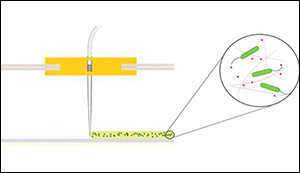Researchers using 3D printed bacteria to make graphene-like material
27. 3. 2017 | 3ders | www.3ders.org
Researchers at the Delft University of Technology in the Netherlands are using 3D printed bacteria to create bespoke, graphene-like materials.
The secret to the new technique is bacteria—3D printed bacteria, to be precise. The researchers have discovered that bacteria can be deposited in precise lines using a 3D printer to turn graphene oxide—a compound of carbon, oxygen, and hydrogen—into a material that closely resembles graphene.

The trick is getting these bacteria to „reduce” the graphene oxide, by pulling oxygen atoms off the material as they metabolize. This process of reduction can also be achieved with heat or chemicals, but the researchers say that bacteria is cheaper and more eco-friendly.
The researchers hacked an ordinary desktop 3D printer to make it print bacteria onto a surface in precise lines just 1 millimeter wide. Printing bacteria is no mean feat, of course, and the researchers had to make a special concoction of E. coli mixed with a gel made from algae. They 3D printed this cocktail onto a dish containing calcium ions, and these calcium ions make the gel solidify upon contact. This keeps the bacteria exactly where they need to be.
Read more at 3ders
Image Credit: Delft University of Technology
-jk-




